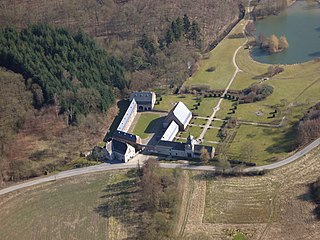
Clairvaux Abbey was a Cistercian monastery in Ville-sous-la-Ferté, 15 kilometres (9.3 mi) from Bar-sur-Aube. The abbey was founded in 1115 by Bernard of Clairvaux and was dissolved during the French Revolution. From 1808 to 2023, the grounds were occupied by Clairvaux Prison, a high-security prison. As of 2024, work is in process to make the space available and attractive to tourists.

Villers Abbey is a former Cistercian abbey located in the town of Villers-la-Ville, Walloon Brabant, Belgium. Founded in 1146, the abbey was abandoned in 1796. Most of the site has since fallen into ruins. These ruins now belong to the Walloon Region and are classified as part of Wallonia's Major Heritage.

Val-Dieu Abbey is a former Cistercian monastery in Wallonia in the Berwinne valley near Aubel in the Pays de Herve.

Vaux-de-Cernay Abbey is a former Cistercian monastery in northern France (Île-de-France), situated in Cernay-la-Ville, in the Diocese of Versailles, Yvelines. The abbey was abandoned during the French Revolution and fell into partial ruin. Most of the buildings, except for the church, were restored in the late 19th century by Charlotte de Rothschild, and the property is now a hotel.

Bonnevaux Abbey is a former Cistercian monastery located in Lieudieu near Villeneuve-de-Marc in the Isère department of France, situated within the Dauphiné region. It is positioned 25 kilometres east of Vienne approximately 6 kilometres south-east of Saint-Jean-de-Bournay, on the northern perimeter of the Forêt de Bonnevaux.

Maubuisson Abbey is a Cistercian nunnery at Saint-Ouen-l'Aumône, in the Val-d'Oise department of France. It was founded in A.D. 1236 by Blanche of Castile, Queen of France, who may have been buried there in 1252. The site is now within the north-western suburbs of Paris. The surviving buildings are listed as a monument historique.
Les Feuillants Abbey, also Feuillant Abbey, was a Cistercian monastery located in the present commune of Labastide-Clermont, about 8 kilometres south of Rieumes, department of Haute-Garonne, France. From the 16th century it was the centre of the Cistercian reform movement to which it gave its name, the Feuillants.

Igny Abbey or Val d'Igny Abbey is a Cistercian abbey located in Arcis-le-Ponsart, Marne, France. It was founded in 1128 for Cistercian monks, dissolved in 1791 during the French Revolution, re-established in 1876 for Trappist monks, destroyed in 1918, reopened in 1929 for Trappist nuns and modernised in 2008–12 to accommodate three or four pre-existing communities.

Perseigne Abbey is a former Cistercian abbey, formally established in 1145 on land given by William III, Count of Ponthieu, and suppressed in 1791 during the French Revolution. It is located in the north of the Sarthe département near to Neufchâtel-en-Saosnois, on the edge of the Perseigne forest, not far from Alençon.

Grandpré Abbey is a former Cistercian abbey located at Faulx-les-Tombes, in the province of Namur, Wallonia, Belgium. The only remains of the abbey are the gatehouse and the attached range at the main entrance, the farm buildings and the mill, once powered by the Samson brook, which crosses the site.

Fontenelle Abbey was a Cistercian nunnery in Maing, Nord, France, extant from 1212 to 1793.

Préaux Abbey was a Benedictine monastery dedicated to Saint Peter at Les Préaux, in Normandy, France.

Cadouin Abbey was a Cistercian monastery founded as a hermitage in 1115 by Gerald of Salles, in the name of Robert of Arbrissel, in what is now the commune of Le Buisson-de-Cadouin in the Dordogne, south-west France.

Fontainejean Abbey, otherwise Fontaine-Jean Abbey, was a Cistercian monastery in the commune of Saint-Maurice-sur-Aveyron in the Gâtinais in the département of Loiret, France.

La Crête Abbey was a Cistercian monastery in the commune of Bourdons-sur-Rognon in the département of Haute-Marne, France.

The Abbaye de la Fille-Dieu is a Cistercian monastery located near the town of Romont in the Swiss Canton of Fribourg. Founded as a Benedictine priory in 1268, and continuously occupied by a community of nuns since its establishment, the alpine abbey is a Swiss heritage site of national significance. Heavily altered through its history, Fille-Dieu was restructured by economic turmoil, fire, additions and unsympathetic alterations. In 1906 the abbey became affiliated with the Trappists, and between 1990 and 1996 an internationally notable restoration was undertaken, modernising the monastic buildings, restoring the abbey church to its original volume, and preserving its rediscovered medieval murals, with the only contemporary element a suite of stained glass windows commissioned from the British artist Brian Clarke. Further restoration of the abbey continues today.

Les Écharlis Abbey is a former Cistercian monastery in Villefranche, Yonne, France. It was founded in the 12th century by a secular priest with two companions who wanted to live a monastic life. Soon afterward, the monastery joined the Cistercian order as a dependency of Fontenay Abbey.

Beaugerais Abbey is a former Cistercian abbey, located in what is now the commune of Loché-sur-Indrois, in the Indre-et-Loire département of France.
















